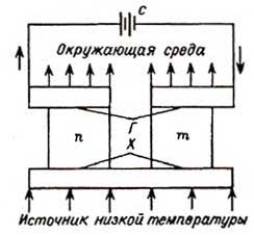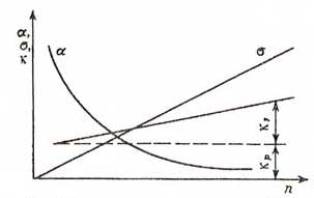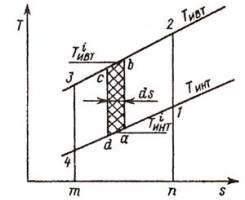Categories: Interesting Facts, Interesting electrical news
Number of views: 38652
Comments on the article: 0
Thermoelectric effect and cooling, Peltier effect
 The economic efficiency of using thermoelectric refrigerators in comparison with other types of refrigerating machines increases the more, the smaller the volume of the cooled volume. Therefore, the most rational at the present time is the use of thermoelectric cooling for household refrigerators, in food liquid coolers, air conditioners, in addition, thermoelectric cooling is successfully used in chemistry, biology and medicine, metrology, as well as in commercial cold (maintaining the temperature in refrigerators) , refrigeration transport (refrigerators), and other areas
The economic efficiency of using thermoelectric refrigerators in comparison with other types of refrigerating machines increases the more, the smaller the volume of the cooled volume. Therefore, the most rational at the present time is the use of thermoelectric cooling for household refrigerators, in food liquid coolers, air conditioners, in addition, thermoelectric cooling is successfully used in chemistry, biology and medicine, metrology, as well as in commercial cold (maintaining the temperature in refrigerators) , refrigeration transport (refrigerators), and other areas
Thermoelectric effect
The effect of occurrence is widely known in the art. thermoEMF in soldered conductors, contacts (junctions) between which are maintained at different temperatures (Seebeck effect) In the case when a constant current is passed through a circuit of two dissimilar materials, one of the junctions starts to heat up, and the other starts to cool. This phenomenon is called thermoelectric effect or Peltier effect.

Fig. 1. Thermocouple diagram
In fig. 1 shows a diagram of a thermocouple. Two semiconductors n and m form a circuit along which direct current passes from the power source C, while the temperature of the cold junctions X becomes lower, and the temperature of the hot junctions G becomes higher than the ambient temperature, i.e., the thermocouple begins to perform the functions of a refrigerating machine.
The junction temperature decreases due to the fact that, under the influence of an electric field, electrons moving from one branch of the thermocouple (m) to another (n) pass into a new state with a higher energy. The energy of electrons increases due to the kinetic energy taken from the atoms of the thermoelement branches in the places of their conjugation, as a result of which this junction (X) is cooled.
In the transition from a higher energy level (branch n) to a low energy level (branch t), the electrons give part of their energy to the atoms of the junction of the thermocouple, which begins to heat up.
In our country in the late 1940s and early 1950s Academician A.F. Ioffe and his students conducted very important research related to the development of the theory of thermoelectric cooling. Based on these studies, a series of cooling devices was first designed and tested.
Energy Efficiency of Thermoelectric Chillers significantly lower than the effectiveness of other types of chillers, but the simplicity, reliability and lack of noise make the use of thermoelectric cooling very promising.
Thermoelectric cooling efficiency
Material selection for items
The efficiency of the thermocouple, as well as the maximum decrease in temperature at the junctions, depend on the efficiency (quality factor) of the semiconductor substance z, which includes the electrical conductivity σ, thermoelectric coefficient α and thermal conductivity κ. These values are interrelated, since they depend on the concentration of free electrons or holes. Such a dependence is presented in Fig. 2.
It can be seen from the figure that the electrical conductivity σ is proportional to the number of carriers n, the thermoEMF tends to zero with increasing n and increases with decreasing n. The thermal conductivity k consists of two parts: the thermal conductivity of the crystal lattice κp, which is practically independent of n, and the electronic thermal conductivity κe, proportional to n.
The effectiveness of metals and metal alloys is low due to the low coefficient of thermoEMF, and in dielectrics due to the very low electrical conductivity.Compared to metals and dielectrics, the efficiency of semiconductors is much higher, which explains their widespread use at present in thermoelements. The effectiveness of materials also depends on temperature.
The thermocouple consists of two branches: negative (n-type) and positive (p-type). Since the material with electron permeability has a negative emf and the material with hole conductivity has a positive sign, a higher thermopower can be obtained.

Fig. 2. Qualitative dependences of thermopower, electrical conductivity and thermal conductivity on carrier concentration
With an increase in thermopower, z increases.
For thermoelements, low-temperature thermoelectric materials are currently used, the starting materials of which are bismuth, antimony, selenium and tellurium. The maximum efficiency z for these materials at room temperature is: 2.6 · 10-3 ° С-1 for the n-type, 2.6 · 10-1 ° С-1 for the p-type.
At present, Bi2Te3 is rarely used, since the Bi2Te3-Be2Se3 and Bi2Te3-Sb2Te3 solid solutions created on its basis have higher z values. These materials were first obtained and studied in our country, and on their basis the production of alloys TVEH-1 and TVEH-2 for branches with electronic conductivity and TVDH-1 and TVDH-2 for branches with hole conductivity was mastered [1].
Bi-Se solid solutions are used in the temperature range below 250 K. The maximum value z = 6 · 10-3 ° C-1 reaches at T≈80 ÷ 90 K. It is interesting to note that the efficiency of this alloy increases significantly in a magnetic field.
Semiconductor branches are currently manufactured by three methods: powder metallurgy, casting with directed crystallization and drawing from the melt. The method of powder metallurgy with cold or hot pressing of samples is the most common.
Thermoelectric cooling devices use, as a rule, thermoelements in which the negative branch is made by hot pressing and the positive branch by cold pressing.

Fig. 3. Thermocouple diagram
The mechanical strength of thermocouples is negligible. So, for samples of the Bi2Te3-Sb2Te3 alloy manufactured by hot or cold pressing, the compressive strength is 44.6–49.8 MPa.
To increase the strength of the thermocouple, a damping lead plate 3 is placed between the switching plate 1 (Fig. 3) and the semiconductor branch 6; in addition, low-melting solders 2, 4 and SiSb 5 solder are used. Tests show that thermoelectric devices have vibration-shock resistance up to 20g, thermoelectric coolers with low cooling capacity up to 250g.
Comparison of thermoelectric cooling devices with other cooling methods
Thermoelectric cooling devices have several advantages over other types of chillers. Currently, ships use air-conditioning or steam chillers in air conditioning systems. In the cold season, ship premises are heated with electric, steam or water heaters, i.e., separate sources of heat and cold are used.
Using thermoelectric devices in the warm season, it is possible to cool the premises, and in the cold - to heat. The heating mode is changed to the cooling mode by reversing the electric current.
In addition, the advantages of thermoelectric devices include: the complete absence of noise during operation, reliability, the absence of a working substance and oil, smaller weight and overall dimensions at the same cooling capacity.
Comparative data on chladon machines for provisioning chambers on ships show that, with the same cooling capacity, the mass of a thermoelectric refrigeration machine is 1.7-1.8 times less.
Thermoelectric chillers for air conditioning systems have a volume of about four and a mass of three times less than chladone chillers.

Fig. 4. The Lorentz cycle
The disadvantages of thermal cooling devices include their low profitability and increased cost.
The cost-effectiveness of thermoelectric refrigerators compared with steam is approximately 20-50% lower [1]. The high cost of thermo-cooling devices is associated with high prices for semiconductor materials.
However, there are areas where they are now able to compete with other types of chillers. For example, they began to use thermoelectric devices for cooling gases and liquids. Examples of devices of this class include potable water chillers, air conditioners, chemical reagent coolers, etc.
For such chillers, the model cycle will be the triangular Lorentz cycle (see Fig. 4). Approaching the model cycle is achieved in a simple way, since this only requires modifying the switching circuitry, which does not cause structural difficulties. This allows you to significantly, in some cases more than double, increase the efficiency of thermoelectric refrigeration machines. To implement this principle in a steam chiller, a complex multi-stage compression scheme would have to be applied.
The use of thermoelectric devices as “Heat transfer enhancer”. In those cases when it is necessary to remove heat from the small space into the environment, and the surface of thermal contact is limited, thermoelectric batteries located on the surface can significantly intensify the heat transfer process.
As studies [2] show, a relatively small energy consumption can significantly increase the specific heat flux. Heat transfer can be intensified even without energy consumption. In this case, close the thermopile.
The presence of a temperature difference will result in Seebeck thermoEMF, which will provide power to the thermoelectric battery. Using thermoelectric devices, it is possible to isolate one of the heat-exchanging media, i.e., use it as a perfect thermal insulation.
An important circumstance, which also determines the area in which thermoelectric chillers are able to compete with other types of chillers even in energy efficiency, is that a decrease in the cooling capacity of, for example, steam chillers leads to a decrease in their refrigeration coefficient.
For a thermoelectric chiller, this rule is not respected, and its effectiveness is practically independent of cooling capacity. Already at present, for temperatures Tx = 0 ° C and Tk = 26 ° C and a performance of several tens of watts, the energy efficiency of a thermoelectric machine is close to the efficiency of a steam refrigeration machine.
Widespread adoption thermoelectric cooling will depend on progress in creating advanced semiconductor materials, as well as on the batch production of economically efficient thermal batteries.
List of references.
1. Tsvetkov Yu. N., Aksenov S. S., Shulman V. M. Ship thermoelectric cooling devices. - L .: Shipbuilding, 1972.— 191 p.
2. Martynovsky V. S. Cycles, circuits, and characteristics of thermal transformers. - M.: Energy, 1979.— 285 p.
Read also on this topic:Peltier effect: the magic effect of electric current
See also at bgv.electricianexp.com
:
